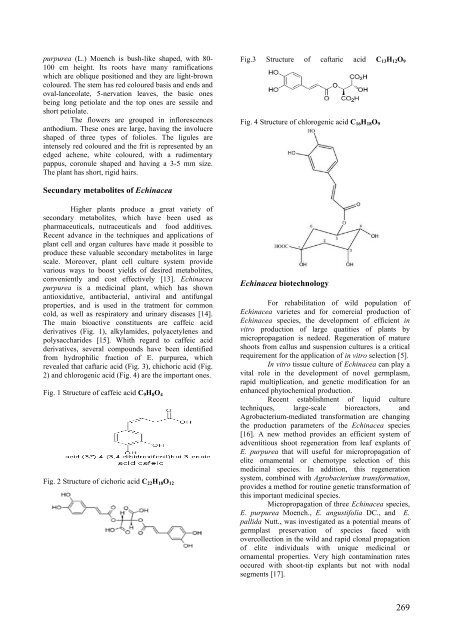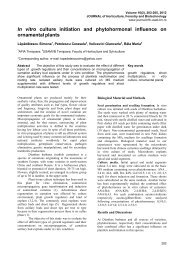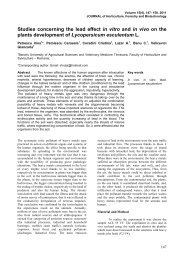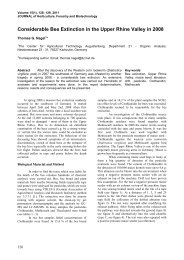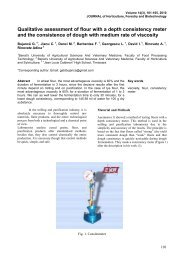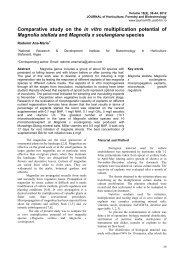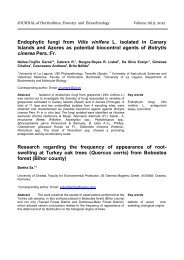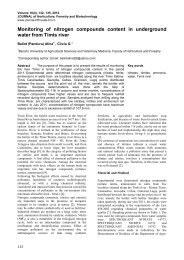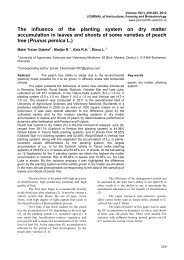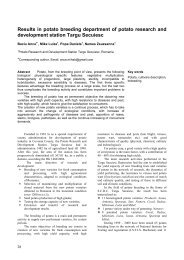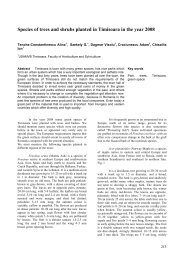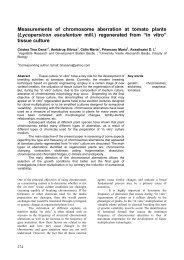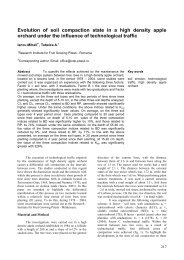The Echinacea species
The Echinacea species
The Echinacea species
You also want an ePaper? Increase the reach of your titles
YUMPU automatically turns print PDFs into web optimized ePapers that Google loves.
purpurea (L.) Moench is bush-like shaped, with 80-<br />
100 cm height. Its roots have many ramifications<br />
which are oblique positioned and they are light-brown<br />
coloured. <strong>The</strong> stem has red coloured basis and ends and<br />
oval-lanceolate, 5-nervation leaves, the basic ones<br />
being long petiolate and the top ones are sessile and<br />
short petiolate.<br />
<strong>The</strong> flowers are grouped in inflorescences<br />
anthodium. <strong>The</strong>se ones are large, having the involucre<br />
shaped of three types of folioles. <strong>The</strong> ligules are<br />
intensely red coloured and the frit is represented by an<br />
edged achene, white coloured, with a rudimentary<br />
pappus, coronule shaped and having a 3-5 mm size.<br />
<strong>The</strong> plant has short, rigid hairs.<br />
Fig.3 Structure of caftaric acid C 13 H 12 O 9<br />
Fig. 4 Structure of chlorogenic acid C 16 H 18 O 9<br />
Secundary metabolites of <strong>Echinacea</strong><br />
Higher plants produce a great variety of<br />
secondary metabolites, which have been used as<br />
pharmaceuticals, nutraceuticals and food additives.<br />
Recent advance in the techniques and applications of<br />
plant cell and organ cultures have made it possible to<br />
produce these valuable secondary metabolites in large<br />
scale. Moreover, plant cell culture system provide<br />
various ways to boost yields of desired metabolites,<br />
conveniently and cost effectively [13]. <strong>Echinacea</strong><br />
purpurea is a medicinal plant, which has shown<br />
antioxidative, antibacterial, antiviral and antifungal<br />
properties, and is used in the tratment for common<br />
cold, as well as respiratory and urinary diseases [14].<br />
<strong>The</strong> main bioactive constituents are caffeic acid<br />
derivatives (Fig. 1), alkylamides, polyacetylenes and<br />
polysaccharides [15]. Whith regard to caffeic acid<br />
derivatives, several compounds have been identified<br />
from hydrophilic fraction of E. purpurea, which<br />
revealed that caftaric acid (Fig. 3), chichoric acid (Fig.<br />
2) and chlorogenic acid (Fig. 4) are the important ones.<br />
Fig. 1 Structure of caffeic acid C 9 H 8 O 4<br />
Fig. 2 Structure of cichoric acid C 22 H 18 O 12<br />
<strong>Echinacea</strong> biotechnology<br />
For rehabilitation of wild population of<br />
<strong>Echinacea</strong> varietes and for comercial production of<br />
<strong>Echinacea</strong> <strong>species</strong>, the development of efficient in<br />
vitro production of large quatities of plants by<br />
micropropagation is nedeed. Regeneration of mature<br />
shoots from callus and suspension cultures is a critical<br />
requirement for the application of in vitro selection [5].<br />
In vitro tissue culture of <strong>Echinacea</strong> can play a<br />
vital role in the development of novel germplasm,<br />
rapid multiplication, and genetic modification for an<br />
enhanced phytochemical production.<br />
Recent establishment of liquid culture<br />
techniques, large-scale bioreactors, and<br />
Agrobacterium-mediated transformation are changing<br />
the production parameters of the <strong>Echinacea</strong> <strong>species</strong><br />
[16]. A new method provides an efficient system of<br />
adventitious shoot regeneration from leaf explants of<br />
E. purpurea that will useful for micropropagation of<br />
elite ornamental or chemotype selection of this<br />
medicinal <strong>species</strong>. In addition, this regeneration<br />
system, combined with Agrobacterium transformation,<br />
provides a method for routine genetic transformation of<br />
this important medicinal <strong>species</strong>.<br />
Micropropagation of three <strong>Echinacea</strong> <strong>species</strong>,<br />
E. purpurea Moench., E. angustifolia DC., and E.<br />
pallida Nutt., was investigated as a potential means of<br />
germplast preservation of <strong>species</strong> faced with<br />
overcollection in the wild and rapid clonal propagation<br />
of elite individuals with unique medicinal or<br />
ornamental properties. Very high contamination rates<br />
occured with shoot-tip explants but not with nodal<br />
segments [17].<br />
269


